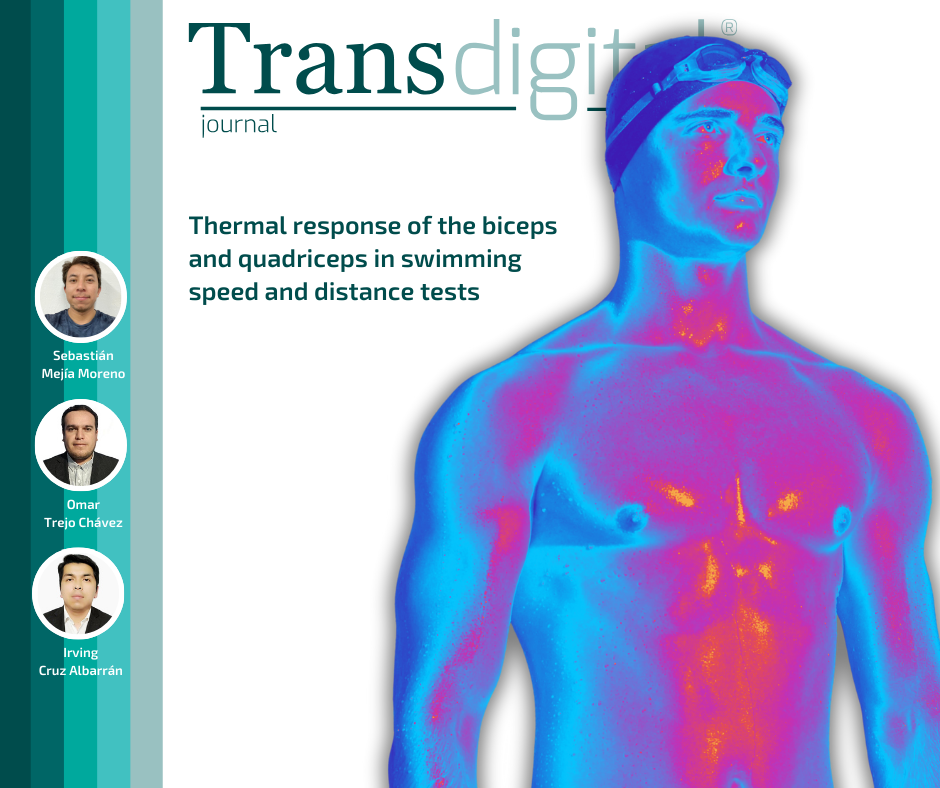Thermal response of the biceps and quadriceps in swimming speed and distance tests
DOI:
https://doi.org/10.56162/transdigital274Keywords:
Infrared thermography, swimming, muscle activationAbstract
Swimming is a sport that requires the activation of different muscle groups. Excessive demand can have a direct impact on the swimmer's condition. Therefore, it is important to monitor muscle activity. This study aimed to demonstrate the differences and similarities of muscle activation through thermography in different swimming styles. The activation of the different muscle groups that participate in each technical gesture, of each of the swimming styles, was identified. Likewise, the thermal increase in the energy requirement of these muscle areas was analyzed. Ten high-performance swimmers were studied; five men and five women, who were divided according to the test they performed, speed or distance. A thermal imaging camera was used to collect the samples. Among the advantages of this technology is that it is a non-invasive and harmless tool. The images were taken at an effective intervention time. Two muscle groups were compared: the biceps of the upper body and the quadriceps of the lower body biceps. During the two study sessions, the pool was at an average temperature of 28°C±1°C. The temperature analysis before the tests shows a maximum temperature reached of 32°C±1°C for each muscle group studied; the temperature difference between the biceps and quadriceps was 1°C ±1°C. Knowing the muscle demand by zone can make training more objective.
References
Abbiss, C. R., Burnett, A., Nosaka, K., Green, J. P., Foster, J. K., & Laursen, P. B. (2010). Effect of hot versus cold climates on power output, muscle activation, and perceived fatigue during a dynamic 100-km cycling trial. Journal of Sports Sciences, 28(2), 117-125. https://doi.org/10.1080/02640410903406216
Bompa, T. O., & Buzzichelli, C. A. (2019). Periodización. Teoría y metodología del entrenamiento. TUTOR.
Cooper, K. H. (1970). The New Aerobics. Bantam Doubleday Dell Publishing Group.
Cruz-Albarran, I. A., Benitez-Rangel, J. P., Osornio-Rios, R. A., & Morales-Hernandez, L. A. (2017). Human emotions detection based on a smart-thermal system of thermographic images. Infrared Physics & Technology, 81, 250-261. https://doi.org/10.1016/j.infrared.2017.01.002
Domingues, A. S., Barbosa, F., Seixas, A., Borgonovo-Santos, M., Pereira, E. M., Vardasca, R., Gabriel, J., Fernandes, R. J., & Vilas-Boas, J. P. (2021). Infrared thermography in swimming: Thermal characterization of swimming technique. En Research Anthology on Business Strategies, Health Factors, and Ethical Implications in Sports and eSports (pp. 795-815). IGI Global.
FINA. World Aquatics. Página web official de la Federación Internacional de Natación. https://www.worldaquatics.com/swimming.
Hamidi Rad, M., Aminian, K., Gremeaux, V., Massé, F., & Dadashi, F. (2021). Swimming phase-based performance evaluation using a single IMU in main swimming techniques. Frontiers in bioengineering and biotechnology, 9. https://doi.org/10.3389/fbioe.2021.793302
Jiménez Gordillo, V. (2018). Diseño de una propuesta metodológica que facilite la detección temprana de alteraciones en extremidades inferiores asociadas a lesiones en el miembro contralateral mediante uso de imágenes infrarojas [Tesis de grado de la Universidad Autónoma de Occidente, Cali, Colombia]. https://red.uao.edu.co/bitstream/handle/10614/10771/T08358.pdf?sequence=6&isAllowed=y.
Verkhoshansky, Y. (2006). Teoría y Metodología del Entrenamiento Deportivo. Paidotribo Editorial.
Wi?ckowski, J., & Ko?odziejczyk, J. (2020). Swimming progression evaluation by assessment model based on the COMET method. Procedia Computer Science, 176, 3514-3523 https://doi.org/10.1016/j.procs.2020.09.035

Downloads
Autor de correspondencia
El autor de correspodencia se identifica con el siguiente símbolo: *Published
How to Cite
License
Copyright (c) 2023 Sebastián Mejía Moreno, Omar Trejo Chávez, Irving Armando Cruz-Albarrán

This work is licensed under a Creative Commons Attribution 4.0 International License.
All articles in Transdigital are licensed under a Creative Commons Attribution 4.0 International License. Authors hold the copyright and retain publishing rights without restrictions.









